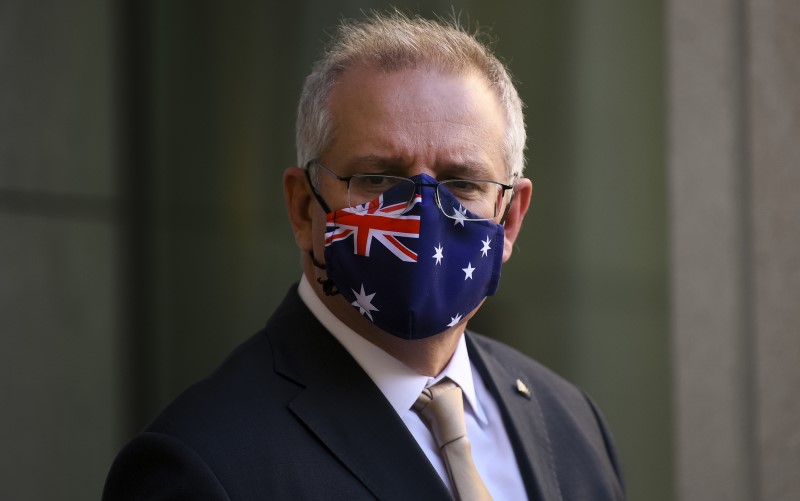
Australia’s COVID-19 vaccine rollout was shemozzle. In the second part of a two-part article, Robin Boyle reviews where we failed.
Despite broad success, the execution of Australia’s Covid vaccine rollout has been shambolic, embarrassing and frightening, with one major bungle after another. Everyone in the country did not have an adequate and fair chance to be vaccinated in a timely manner. For much of 2021, many Australians waited unvaccinated through no fault of their own.
Major problems in the rollout include not ordering enough mRNA vaccines, not being able to quickly vaccinate those most-at-risk, and too quickly accepting advice from ATAGI to prefer Pfizer for certain age groups. From April we had the bizarre situation where many of those under 60 were implored to get vaccinated yet there were insufficient Pfizer doses in the country for them.
Many of those deemed to be most at risk, in particular First Nations people, were effectively de-prioritised and have ended up at the back of the queue. This lamentable delay has allowed vaccine hesitancy amongst them to explode due to misinformation and conspiracy theories. It remains a major problem for Australia as Indigenous leaders have warned that not only whole settlements might be wiped out but languages will be lost with them.
By mid-year, Australia was lagging way behind other comparable countries in its vaccine rollout. A quarantine outbreak in Sydney in June would lead to the Delta variant escaping into NSW, Victoria and the ACT. A new plan was needed. What we got had good and bad parts.
Yesterday we examined the good parts. Here are the bad parts.
The national plan and Covid shield
Unveiled at the end of July, Scott Morrison’s so-called national plan was to be a controlled opening up process to take place at the same time as the recalibrated vaccination program was rolled out under the separate “Covid shield” plan.
The presentation to national cabinet for its meeting on August 6 incorporated the Doherty report about modelling for key vaccination rates for moving between phases. We were told the targets in the plan were agreed to by all the states and territories at that meeting.
While the national plan is a simple one- page document, it is interesting to check the Covid shield and the Doherty documents to see the excruciating and incomprehensible detail they involved. Whilst the reports were clearly destined for experts, did any of our decision makers really know what these new plans meant?
It is unlikely any of the state or territory leaders nor their staff could fully comprehend what was put before them on the day of the national cabinet meeting, or even with a few days’ notice beforehand. What should have been a relatively simple planning task, was botched.
Within days of being “fully accepted” the national plan was being dismantled as too many parts were “unpalatable”. The conditions for transitioning between phases are probably the reason the plan folded, and are the main concern I discuss here.
The four phases for transitioning gave structure to opening up and were good parts of the “egg’’. Doherty’s target points of 70 per cent and 80 per cent proved very useful as it gave everyone “round” numbers that were meaningful and easy to work with — for the PM, state and territory leaders, health officials and the people in the street.
But those two numbers were also the bad parts, as they were presented as blanket aggregate rates to apply regardless of whether or not there was an even uptake across regions, age groups, socioeconomic groups and ethnic groups.
It was a case of “stupidity percentified”.
As we wrote in Pearls and Irritations on September 10, it was certain there would be very high vaccine uptake in the cities and towns, potentially leaving very low vaccination rates in regional and remote areas. But once these broad city targets were hit, the vaccinated and unvaccinated could be unleashed on those still vulnerable.
We explained how our First Nations people, along with other marginalised and disadvantaged groups, were “thrown under the bus” by the Doherty modelling. Thus we explained that we could have 80 per cent vaccine uptake nationwide by achieving 90 per cent or higher in our major cities yet have under 50 per cent or even under 30 per cent in some regional centres and remote Indigenous communities. The Guardian has a very useful vaccine data tracker. It includes tables and charts illustrating the uneven rollout around the country.
The concerns were raised by Indigenous communities in August. The first Covid death of a NT resident was that of an Indigenous woman.
The work by Doherty — an organisation purporting to protect the health of the Aboriginal and Torres Strait Islander communities but who were effectively ignored in its initial report — surely has to be questioned. The “next steps” it foreshadowed in its report of August 10 “focusing on key subpopulations including First Nations Australians” did not appear until November 5. By then the bus had well and truly bolted! Thousands of our Indigenous people could have succumbed to the disease while for months their researchers and modellers dithered and mulled. We also note that that tardy report is not only also extremely difficult to understand, but it seems to be irrelevant, meaningless and useless.
There were other major problems too. The overall plan and associated modelling were even described as being “full of weasel-words and caveats, which means it is impossible for anyone to be held to account” and hard “to know exactly what premiers signed up to”.
The states and territories soon realised they had to have special arrangements for their citizens. Clearly the needs for the NT and WA, with their large areas and Indigenous populations, would be quite different to those for the ACT and Tasmania. Some states and territories would make 90 per cent their key transition point.
Implementation of the plan was selective, biased and targeted
When the various flaws in the plan were revealed, state and territory leaders began exerting their own authority. Most leaders acted responsibly. However, eventually a situation akin to herding cats would develop, with NSW being the first cat out of the bag, clearly breaking the rules that other jurisdictions had apparently agreed to.
On that, we note that there are at least two versions of the national plan published on federal government websites. This version includes this distinct statement right at the top:
“Phases [to be] triggered in a jurisdiction when the average vaccination rates across the nation have reached the threshold and that rate is achieved in a jurisdiction expressed as a percentage of the eligible population (16+).”
Whereas this version reduces that statement to a throwaway line right at the end:
“Phases are triggered when average vaccination rates are achieved across the nation.”
It seems to be a dumbed down version to spin the plan. Of particular note is the statement that the “modelling from the Doherty Institute has given Australia a clear path and targets for how to do that”. In fact, as stated above, the modelling is far from clear.
Thus we found NSW seemingly publishing its intentions, making decisions and taking action before a) the nation had reached a threshold, say 70 per cent, and b) NSW had also reached 70 per cent. For the PM, who is quick to remind that all leaders had agreed to the plan, it was noticeable that he ignored NSW jumping the gun. In particular opening up to international flights meant Victoria was pressured to quickly follow suit; the ACT was caught in the middle. Other jurisdictions drew back and became even more cautious about increased infections arriving from overseas and from the general loosening of restrictions within the two most populace states.
So with international travel opening from November 1 our PM presided over a country where it was easier for some Australians to travel to other countries than to some states.
While NSW seemed incapable of doing any wrong, from the PM and his senior ministers we seemed to have continued denigration and targeting of the Labor states of WA, Victoria and Queensland. Yet we heard not a complaint about Liberal states following basically the same Covid prevention policies, in particular, Tasmania and SA, nor indeed about New Zealand, which won’t open borders until January.
A federal Liberal-National Coalition government seems incapable of good outcomes
With our Covid experience, what has been emphatically confirmed, and something we have been beset with since the Abbott government, is that producing plans that are solid and last the course is beyond a Liberal-National Coalition government’s capabilities.
Sidelining public servants and government departments and outsourcing key roles of handling aspects of the infection control, quarantining and vaccine rollout to the private sector may be a major contributor to the shemozzle. Have the Australian taxpayers been handing over billions of dollars for services that were questionable in terms of value for money and quality of delivery?
Misinformation has been allowed to proliferate through the right-wing media, through extremist organisations, recalcitrant MPs and social media. The PM himself seems to want to take a bet each way by sympathising with affected Australians but also with those involved in disruptive and frightening protests, merely providing fuel for the anger and division around the country. He takes another bet each way by lauding our uptake yet not endorsing widespread mandating (which has been important in achieving outcomes), leaving it to the state and territory governments who have really done all the hard yards.
Vaccine hesitancy has been allowed to proliferate, with no apparent plan by the federal government to solve the consequential problems. The country is confused about vaccination status. Have NSW and the PM raised the possibility of a form of moral hazard, telling Australians to get vaccinated but that at a certain point of time the unvaccinated will be free as anyone else (like fining people then dropping the fines later)? Should someone who is fully vaccinated have to work with others who aren’t; or shop with them or eat with them in a restaurant, or travel with them on a plane or train, or stand in front of them to teach? Should someone who has had a heart attack or been seriously injured be deprived of the best medical attention due to those who choose not to be vaccinated overwhelming intensive care wards?
And what about the more distant future? The federal government does not seem to be thinking about anything else but winning the next election. As the PM wastes days failing to convince the former NSW premier to run for federal parliament, governing the country is overlooked. Where is the planning for the next pandemic? How serious is the government about building specialised quarantine facilities? mRNA manufacturing capability was first promised 14 months ago and it was only this week that a deal between Moderna and the Australian and Victorian governments to build such a facility was announced — to be operational by 2024.
By practically any objective measure on Covid and other matters, the Morrison government does not deserve to be re-elected. If the Morrison government can’t produce a plan to save us from a two-year pandemic, we can bet they cannot produce a plan that will help save us from climate catastrophe in the coming decades.
In 2016, the outgoing US ambassador described Australians as the “most rational people in the world“. Because of us, and not because of great planning or leadership from Canberra, Australia has survived Covid in reasonable shape so far.




